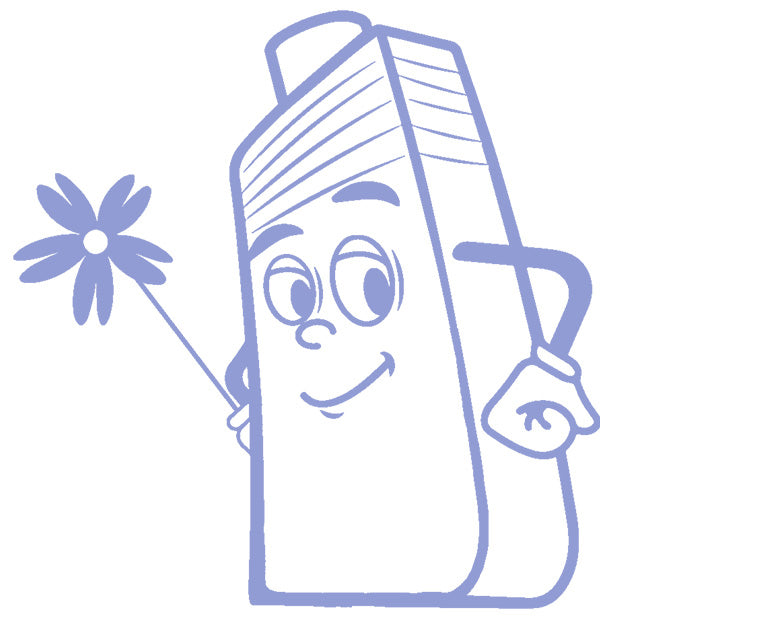But if your shampoo contains bad silicone for hair, your shampoo may be doing more harm than good, especially if you’re also using a shampoo containing sulfates. Keep reading to learn more about silicone and shampoo, and how to find the best sulfate and silicone-free shampoo and conditioner.
Index
What is Silicone in Shampoo?
Silicone is a chemical compound found in many cosmetic products, including shampoo. Silicones are polymers derived from silica, a natural mineral. Silicones can have many different names, but they usually end in “-cone” (i.e. “dimethicone”).
Silicone in shampoo coats each hair strand, locking out frizz-causing humidity. Think of it as a raincoat for your hair! Silicone in shampoo can also help to improve hair’s shine and manageability. If you’ve ever used a new shampoo and condition and noticed an instant improvement in your hair’s appearance, that’s thanks to silicones!
But here’s the thing: since silicones only coat the hair, they don't do anything to improve its condition. And in fact, they can harm your hair’s health.
Why You Should Choose a Sulfate and Silicone-Free Shampoo
Silicones do have a lot of benefits for the hair, at least aesthetically. However, silicone in shampoo can also have a dark side.
As we mentioned before, silicone does not penetrate the hair. Instead, it creates a film on top which can prevent other helpful ingredients from reaching the hair shaft. If you use a shampoo with "bad silicones" for hair (more on bad silicones for hair below), you may experience one of two issues:
- Dry hair. Since silicone in shampoo prevents hydrating ingredients from penetrating your hair, your hair may become dry and brittle over time.
- Greasy hair. As your hair becomes drier, your scalp may produce more oil to compensate. The result? Oily-looking hair. This can trigger a dangerous cycle. If your hair looks oily, you should wash it, right? But washing more often with shampoo containing bad silicones for hair will only exacerbate the issue.

So what does buildup from silicone look like? It depends on your hair type. If you have straight or fine hair, the build-up will make your hair look limp and lifeless. Silicone build-up may mean less bouncy curls or a loss of curl altogether if you have curly hair.
Signs that your hair is experiencing negative effects from silicone in shampoo: the hair routine that once left you with shiny, healthy-looking locks is no longer working. If your shampoo and conditioner suddenly stop working like they used to, you may have a buildup of silicone on your hair.
Unlike other ingredients considered “bad” for hair, silicones aren’t harmful to your health. However, buildup from silicones on the scalp can cause an itchy rash. Silicones are also comedogenic, which means they clog the pores. If you are prone to acne, silicone in shampoo could make your scalp breakouts worse.
Hint: if you are experiencing a dry, itchy scalp due to silicone in shampoo, try Grow Perfect™ Thickening Spray. This spearmint-infused formula provides soothing relief for irritated scalps. Plus, it gives hair instant volume and may even promote healthy hair growth!
There’s another reason why you should choose a silicone-free shampoo: silicones are bad for the environment. Since the bad silicones for hair don’t break down easily in water, that means that they are non-biodegradable. When you wash your hair, silicones rinse down the drain. Eventually, these silicones accumulate in the water supply and cause pollution.

So what about sulfates? Bad silicones for hair and sulfates are designed to work together since sulfates' abrasive properties wash away silicone buildup. For example, a shampoo and conditioner duo may contain silicones in the conditioner to improve the shine and manageability of hair. To wash away the buildup for silicones, the shampoo may contain harsh sulfates. Over time, washing and conditioning hair with sulfates and silicones can lead to dry, brittle hair that’s prone to breakage. For healthier hair, opt for sulfate and silicone-free shampoo and conditioner.
What Are Bad Silicones for Hair?
Not all types of silicone are bad silicones. Silicones are stable, which means they do not degrade when exposed to heat or UV light. This means that they are helpful in products that are used to protect hair against heat styling tools or direct sunlight.
However, if you are using silicone hair products regularly, you’ll also want to use a clarifying shampoo without silicone to remove build-up. Alternatively, you can use silicone-free styling products like Thermal Shield™ Heat Protectant or Ocean Water Sea Salt Spray to prevent build-up from occurring in the first place.
Where you don’t want silicone is in your moisturizing products. As we mentioned before, silicone cannot penetrate the hair. Thus, it does nothing to hydrate parched strands. That’s why it’s important to choose a silicone-free shampoo and conditioner, especially if you have dry, damaged, or thinning hair.
Not all types of silicone in shampoo are created equal. There are two main types of silicone in shampoo: water-soluble and fat-soluble.
Water-Soluble Silicones
Using regular shampoo and water, water-soluble silicone in shampoo and other products can easily be rinsed out of the hair. Sometimes these silicones are referred to as “breathable”. They provide the shine and conditioning effect of silicones without the buildup as they easily and simply can be rinsed out with water. Some types of water-soluble silicone in shampoo include:
- Dimethicone Copolyol
- Lauryl Methicone Copolyol
- PEG-8 Dimethicone
- PEG-12 Dimethicone
- Dimethicone PEG-8 Succinate
- Amodimethicone (when the ingredients Trideceth-12 og Cetrimonium Chloride are present within the same formula)
Fat-Soluble Silicones
Fat-soluble silicone in shampoo is difficult to remove from the hair and scalp and may require a sulfate shampoo or a clarifying scalp scrub like Scalp Delight™ Detox Scrub (silicone and sulfate-free). Some ingredient names to look out for include:
- Dimethicone
- Cyclomethicone
- Amodimethicone (when the ingredients Tricedeth-12 and Centrimonium Chloride are not present within the same formula)
- Phenyl Trimethicone
- Cetearyl Methicone
- Dimethiconol
- Stearyl Dimethicone
For healthier hair, make sure to thoroughly inspect the ingredients list of your shampoo bottle for fat-soluble AKA “bad” silicones.
What to Do if There’s Silicone in Shampoo
So what should you do if your current shampoo contains bad silicones with hair? The first thing to do is to use a clarifying shampoo, like Scalp Delight™ ACV Clarifying Shampoo. This sulfate and silicone-free shampoo gently removes shine-dulling and itchy residue from the scalp.
Use this shampoo for a dry and itchy scalp with the Scalp Delight™ Scalp Massage Brush to improve your results. The Scalp Delight™ Scalp Massage Brush has soft bristles that improve circulation and gently exfoliate the scalp. Plus, it just feels really good!
How to Find the Best Shampoo Without Silicone
So how do you find the best shampoo without silicone? Many shampoos that are labeled “silicone-free” actually just don’t include bad silicones for hair. That’s why it’s important to reference the list above when shopping for a silicone-free shampoo and conditioner. If you want to avoid silicone in shampoo altogether, look for products with natural emollients and conditioning agents like botanical oils.
Need help? These are our recommendations for the best silicone-free shampoos by hair type.
The Best Silicone-Free Shampoo for Damaged Hair
Damaged hair prone to breakage has unique needs and thus needs a uniquely formulated silicone-free shampoo. We recommend Split Fix™ Shampoo, which gently cleanses hair while providing long-lasting hydration and nourishment to prevent breakage. For best results use silicone-free shampoo and conditioner together. This shampoo without silicone pairs with Split Fix™ Conditioner, a silicone-free conditioner.
The Best Silicone-Free Shampoo for Thinning Hair
People experiencing hair thinning can also benefit from using a silicone-free shampoo like Grow Perfect™ Shampoo. This particular formula helps to improve hair growth and density, with clinically proven ingredients like Anagain™ and organic rosemary oil. Pair it with silicone-free Grow Perfect™ Conditioner for best results.
The Best Silicone-Free Shampoo for Dry Hair
Those with frizzy, coarse and very dry hair can see a huge difference in their hair when switching to silicone-free alternatives. I recommend opting for a deeply hydrating products enriched with plenty of nourishing plant extracts and moisture sealing proteins, like Moisture Hero™ Shampoo and Moisture Hero™ Conditioner. If you ask me, it is one the best shampoos for dry hair!
The Best Silicone-Free Shampoo for Curls
Promote healthy curly hair with Curl Crush™ Shampoo, a silicone-free shampoo. An active blend of vegan micro-proteins, bamboo extract, and a moisturizing sugar complex reconstruct and hydrate frizzy hair for smooth, defined curls.
Curly hair is especially prone to dryness, so make sure to use silicone-free shampoo and conditioner together. For a silicone-free conditioner for curls, we recommend Curl Crush™ Conditioner.
Another popular method of washing curly hair is co-washing, meaning using only conditioner to wash your hair. Co-wash products, like the silicone-free Curl Crush™ Co-Wash, are especially suited for dry, frizzy and porous curls.
The Best Silicone-Free Volume Shampoo
If you have fine or flat hair - or would just like to add extra oomph to your strands - try the Volume Wizard™ Shampoo. This volumizing silicone-free shampoo is based on a strengthening, volume-boosting, and nourishing yet lightweight formula.
To amp up the volume even further pair it with Volume Wizard™ Conditioner.
The Best Silicone-Free Shampoo for Blondes
The best silicone-free shampoo for blondes has a special ingredient: purple pigment. Enriched Blonde™ Silver Shampoo repairs damaged locks while neutralising brassiness. For best results, combine it with Enriched Blonde™ Silver Conditioner, a silicone-free conditioner.
What About Silicone-Free Conditioners?
You should opt for a silicone-free conditioner for the same reason you should opt for a silicone-free shampoo. Bad silicone for hair builds up on the hair shaft, leading to brittle and oily-looking hair. It doesn’t matter whether that bad silicone is in your shampoo, conditioner, or styling products. It will have the same effect! Instead, choose a silicone-free conditioner that uses natural botanical ingredients like aloe vera, shea butter, or olive oil to provide hydration and shine for hair.
Tip: For extra hydration and nourishment try a silicone-free hair oil or a leave-in conditioner, like Split Fix™ Leave-in Conditioner. It wraps hair in a conditioning veil to rebuild the structure of damaged, fragile hair and help smooth split ends, leaving your hair smooth, soft, and healthier-looking.
How to Switch to a Silicone-Free Shampoo and Conditioner
Ready to make the switch? Follow these steps to switch to using a silicone-free shampoo and conditioner.
Step One: Gently Clarify Hair

Remove all traces of bad silicones for hair by washing with a sulfate-free clarifying shampoo like Scalp Delight™ ACV Clarifying Shampoo. For best results, wash your hair with Scalp Delight™ Scalp Massage Brush.
Step Two: Deep Condition

After using silicone in shampoo for a long time, your hair may be extra parched. Apply Split Fix™ Hair Mask to hair, paying special attention to the ends. This deep conditioning agent is rich in naturally hydrating botanicals like organic aloe vera, acai berry extract, and jojoba esters. Plus, it contains ingredients that promote hair growth like caffeine. Let the product sit for five to ten minutes to work its magic, then rinse out with cool water.
Step Three: Wash Hair

Next time you wash your hair, use sulfate and silicone-free shampoo and conditioner. Over time, hair will look better and better as its health improves!
So, what’s next? We encourage you to check the ingredient label on your favorite shampoo for bad silicones for hair. Switching to sulfate and silicone-free shampoo and conditioner could be the solution to your best hair ever!











































































